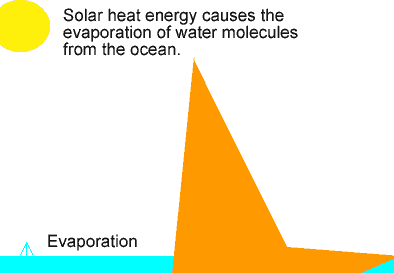Water cycle

The rain that we see falling from the
clouds originated from oceans and forests many kilometres away. The sun
provides the energy to evaporate water from oceans, lakes and forests.
The water vapour rises and forms clouds. The clouds are carried by winds
inland where they rise over mountain ranges and cool down. As the water
vapour in the clouds cools it condenses into water. The water then falls
as rain. It flows via streams and underground water-ways into lakes and
back into the ocean. Some of the water that falls on land is absorbed
by the roots of plants and sucked out from the leaves back into the atmosphere.
Pollution degrades the purity of rain water. Some pollutants such as sulfur dioxide, nitrous oxide and carbon dioxide combine with water to form the acids sulfuric acid , nitric acid and carbonic acid respectively. The rain that
falls is so acidic that it is called acid rain. Acid rain destroys the roots of trees and over time can completely wipe out entire forests. Most of the pollutants come from the burning of fossil fuels especially in power generation industry.

Pollution degrades the purity of rain water. Some pollutants such as sulfur dioxide, nitrous oxide and carbon dioxide combine with water to form the acids sulfuric acid , nitric acid and carbonic acid respectively. The rain that
falls is so acidic that it is called acid rain. Acid rain destroys the roots of trees and over time can completely wipe out entire forests. Most of the pollutants come from the burning of fossil fuels especially in power generation industry.
